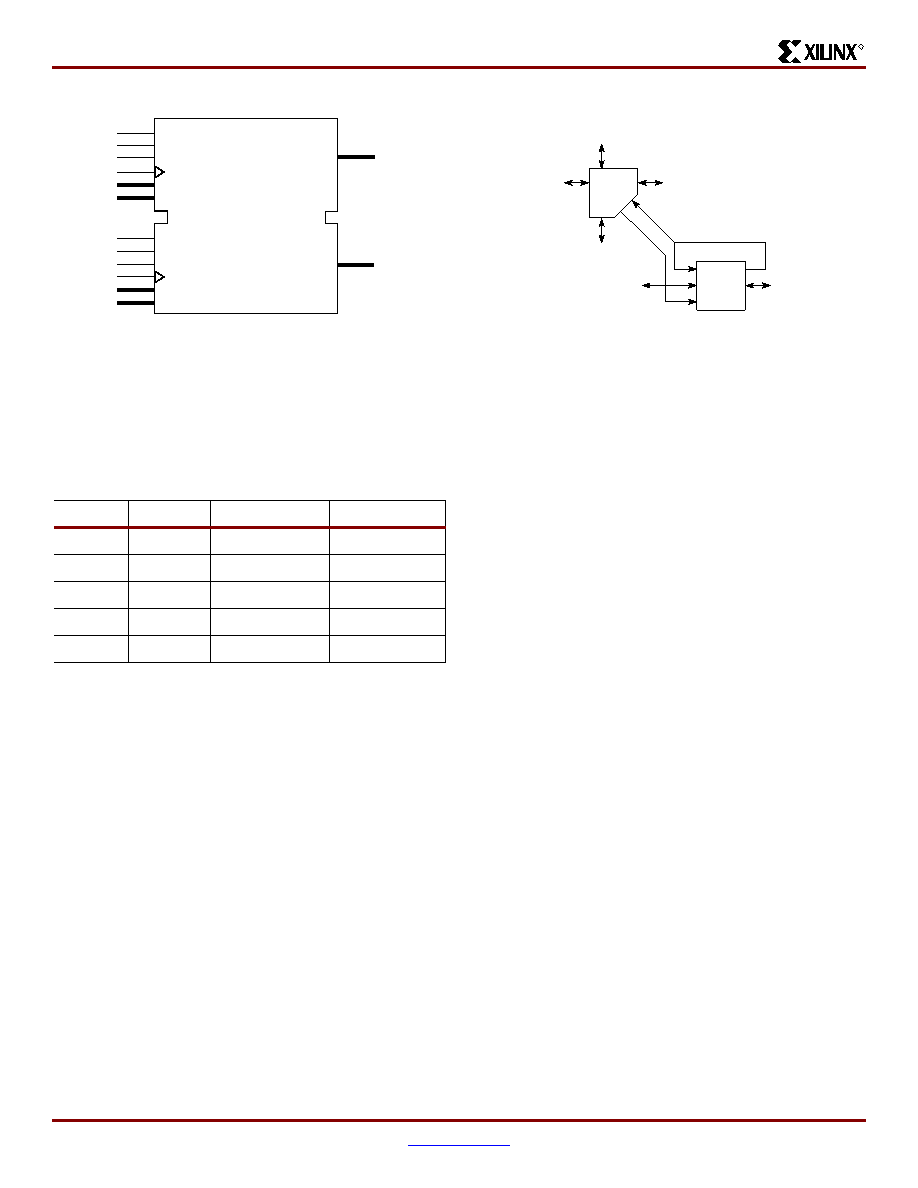- 您現(xiàn)在的位置:買賣IC網(wǎng) > PDF目錄4214 > XCV405E-8FG676C (Xilinx Inc)IC FPGA 1.8V C-TEMP 676-FBGA PDF資料下載
參數(shù)資料
| 型號: | XCV405E-8FG676C |
| 廠商: | Xilinx Inc |
| 文件頁數(shù): | 2/118頁 |
| 文件大?。?/td> | 0K |
| 描述: | IC FPGA 1.8V C-TEMP 676-FBGA |
| 產(chǎn)品變化通告: | FPGA Family Discontinuation 18/Apr/2011 |
| 標(biāo)準(zhǔn)包裝: | 1 |
| 系列: | Virtex®-E EM |
| LAB/CLB數(shù): | 2400 |
| 邏輯元件/單元數(shù): | 10800 |
| RAM 位總計: | 573440 |
| 輸入/輸出數(shù): | 404 |
| 門數(shù): | 129600 |
| 電源電壓: | 1.71 V ~ 1.89 V |
| 安裝類型: | 表面貼裝 |
| 工作溫度: | 0°C ~ 85°C |
| 封裝/外殼: | 676-BGA |
| 供應(yīng)商設(shè)備封裝: | 676-FBGA(27x27) |
第1頁當(dāng)前第2頁第3頁第4頁第5頁第6頁第7頁第8頁第9頁第10頁第11頁第12頁第13頁第14頁第15頁第16頁第17頁第18頁第19頁第20頁第21頁第22頁第23頁第24頁第25頁第26頁第27頁第28頁第29頁第30頁第31頁第32頁第33頁第34頁第35頁第36頁第37頁第38頁第39頁第40頁第41頁第42頁第43頁第44頁第45頁第46頁第47頁第48頁第49頁第50頁第51頁第52頁第53頁第54頁第55頁第56頁第57頁第58頁第59頁第60頁第61頁第62頁第63頁第64頁第65頁第66頁第67頁第68頁第69頁第70頁第71頁第72頁第73頁第74頁第75頁第76頁第77頁第78頁第79頁第80頁第81頁第82頁第83頁第84頁第85頁第86頁第87頁第88頁第89頁第90頁第91頁第92頁第93頁第94頁第95頁第96頁第97頁第98頁第99頁第100頁第101頁第102頁第103頁第104頁第105頁第106頁第107頁第108頁第109頁第110頁第111頁第112頁第113頁第114頁第115頁第116頁第117頁第118頁

Virtex-E 1.8 V Extended Memory Field Programmable Gate Arrays
Module 2 of 4
DS025-2 (v3.0) March 21, 2014
6
R
— OBSOLETE — OBSOLETE — OBSOLETE — OBSOLETE —
Table 5 shows the depth and width aspect ratios for the
block SelectRAM. The Virtex-E block SelectRAM also
includes dedicated routing to provide an efficient interface
with both CLBs and other block SelectRAM modules. Refer
to XAPP130 for block SelectRAM timing waveforms.
Programmable Routing Matrix
It is the longest delay path that limits the speed of any
worst-case design. Consequently, the Virtex-E routing
architecture and its place-and-route software were defined
in a joint optimization process. This joint optimization mini-
mizes long-path delays, and consequently, yields the best
system performance.
The joint optimization also reduces design compilation
times because the architecture is software-friendly. Design
cycles are correspondingly reduced due to shorter design
iteration times.
Local Routing
The VersaBlock, shown in Figure 7, provides local routing
resources with the following types of connections:
Interconnections among the LUTs, flip-flops, and GRM
Internal CLB feedback paths that provide high-speed
connections to LUTs within the same CLB, chaining
them together with minimal routing delay
Direct paths that provide high-speed connections
between horizontally adjacent CLBs, eliminating the
delay of the GRM
.
General Purpose Routing
Most Virtex-E signals are routed on the general purpose
routing, and consequently, the majority of interconnect
resources are associated with this level of the routing hier-
archy. The general routing resources are located in horizon-
tal and vertical routing channels associated with the CLB
rows and columns. The general-purpose routing resources
are listed below.
Adjacent to each CLB is a General Routing Matrix
(GRM). The GRM is the switch matrix through which
horizontal and vertical routing resources connect, and
is also the means by which the CLB gains access to
the general purpose routing.
24 single-length lines route GRM signals to adjacent
GRMs in each of the four directions.
72 buffered Hex lines route GRM signals to another
GRMs six-blocks away in each one of the four
directions. Organized in a staggered pattern, Hex lines
are driven only at their endpoints. Hex-line signals can
be accessed either at the endpoints or at the midpoint
(three blocks from the source). One third of the Hex
lines are bidirectional, while the remaining ones are
uni-directional.
12 Longlines are buffered, bidirectional wires that
distribute signals across the device quickly and
efficiently. Vertical Longlines span the full height of the
device, and horizontal ones span the full width of the
device.
I/O Routing
Virtex-E devices have additional routing resources around
their periphery that form an interface between the CLB array
and the IOBs. This additional routing, called the VersaRing,
facilitates pin-swapping and pin-locking, such that logic
redesigns can adapt to existing PCB layouts. Time-to-mar-
ket is reduced, since PCBs and other system components
can be manufactured while the logic design is still in prog-
ress.
Figure 6: Dual-Port Block SelectRAM
Table 5:
Block SelectRAM Port Aspect Ratios
Width
Depth
ADDR Bus
Data Bus
1
4096
ADDR<11:0>
DATA<0>
2
2048
ADDR<10:0>
DATA<1:0>
4
1024
ADDR<9:0>
DATA<3:0>
8
512
ADDR<8:0>
DATA<7:0>
16
256
ADDR<7:0>
DATA<15:0>
WEB
ENB
RSTB
CLKB
ADDRB[#:0]
DIB[#:0]
WEA
ENA
RSTA
CLKA
ADDRA[#:0]
DIA[#:0]
DOA[#:0]
DOB[#:0]
RAMB4_S#_S#
ds022_06_121699
Figure 7: Virtex-E Local Routing
XCVE_ds_007
CLB
GRM
To
Adjacent
GRM
To Adjacent
GRM
Direct
Connection
To Adjacent
CLB
To Adjacent
GRM
To Adjacent
GRM
Direct Connection
To Adjacent
CLB
相關(guān)PDF資料 |
PDF描述 |
|---|---|
| XCV405E-7FG676I | IC FPGA 1.8V 676-BGA |
| XC6VLX195T-1FFG784C | IC FPGA VIRTEX 6 199K 784FFGBGA |
| XC6VCX130T-2FFG784I | IC FPGA VIRTEX 6 128K 784FFGBGA |
| XC4VLX60-11FF668I | IC FPGA VIRTEX-4LX 668FFBGA |
| XC4VLX60-12FFG668C | IC FPGA VIRTEX-4 LX 60K 668FCBGA |
相關(guān)代理商/技術(shù)參數(shù) |
參數(shù)描述 |
|---|---|
| XCV405E-8FG676I | 制造商:XILINX 制造商全稱:XILINX 功能描述:Virtex-E 1.8 V Extended Memory Field Programmable Gate Arrays |
| XCV405E-8FG900C | 制造商:XILINX 制造商全稱:XILINX 功能描述:Virtex-E 1.8 V Extended Memory Field Programmable Gate Arrays |
| XCV405E-8FG900I | 制造商:XILINX 制造商全稱:XILINX 功能描述:Virtex-E 1.8 V Extended Memory Field Programmable Gate Arrays |
| XCV50 | 制造商:XILINX 制造商全稱:XILINX 功能描述:Field Programmable Gate Arrays |
| XCV50-4BG256C | 功能描述:IC FPGA 2.5V C-TEMP 256-PBGA RoHS:否 類別:集成電路 (IC) >> 嵌入式 - FPGA(現(xiàn)場可編程門陣列) 系列:Virtex® 標(biāo)準(zhǔn)包裝:1 系列:Kintex-7 LAB/CLB數(shù):25475 邏輯元件/單元數(shù):326080 RAM 位總計:16404480 輸入/輸出數(shù):350 門數(shù):- 電源電壓:0.97 V ~ 1.03 V 安裝類型:表面貼裝 工作溫度:0°C ~ 85°C 封裝/外殼:900-BBGA,F(xiàn)CBGA 供應(yīng)商設(shè)備封裝:900-FCBGA(31x31) 其它名稱:122-1789 |
發(fā)布緊急采購,3分鐘左右您將得到回復(fù)。